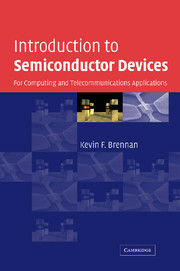Book contents
- Frontmatter
- Contents
- Preface
- List of physical constants
- List of materials parameters for important semiconductors, Si and GaAs
- 1 Semiconductor fundamentals
- 2 Carrier action
- 3 Junctions
- 4 Bipolar junction transistors
- 5 JFETs and MESFETs
- 6 Metal–insulator–semiconductor structures and MOSFETS
- 7 Short-channel effects and challenges to CMOS
- 8 Beyond CMOS
- 9 Telecommunications systems–an overview
- 10 Optoelectronic devices – emitters, light amplifiers, and detectors
- 11 Transistors for high frequency, high power amplifiers for wireless systems
- References
- Index
9 - Telecommunications systems–an overview
Published online by Cambridge University Press: 05 June 2012
- Frontmatter
- Contents
- Preface
- List of physical constants
- List of materials parameters for important semiconductors, Si and GaAs
- 1 Semiconductor fundamentals
- 2 Carrier action
- 3 Junctions
- 4 Bipolar junction transistors
- 5 JFETs and MESFETs
- 6 Metal–insulator–semiconductor structures and MOSFETS
- 7 Short-channel effects and challenges to CMOS
- 8 Beyond CMOS
- 9 Telecommunications systems–an overview
- 10 Optoelectronic devices – emitters, light amplifiers, and detectors
- 11 Transistors for high frequency, high power amplifiers for wireless systems
- References
- Index
Summary
In this chapter we examine the basics of optical and mobile telecommunications systems that impact semiconductor devices. Our aim is to determine the principal characteristics of lightwave and mobile telecommunications systems that influence device selection. Lightwave communications systems are based on optical fibers and several device components are needed to support lightwave transmission, encoding, amplification, detection, and decoding. The device components used within lightwave systems fall into two general categories: optoelectronic and optical. In mobile telecommunications systems the device types of greatest importance are high frequency, high power transistors. Here we will briefly outline how some of the system requirements influence device choice and dictate their performance.
Fiber transmission
There are several important advantages to fiber optic communication systems. These can be summarized as:
(1) Smaller diameter, lighter weight, and increased flexibility.
(2) Relatively low cost compared to copper cables. Fiber optic cables are relatively inexpensive due to the low cost of the materials employed.
(3) Good isolation and cross-talk immunity.
(4) Low transmission loss and dispersion.
(5) High security in transmission. There is little signal “spilling” from the fiber if properly shielded in contrast to that for copper systems.
(6) Tremendous capacity. As we will see below, the capacity of existing fiber optic lines as measured by bandwidth is measured in terahertz.
For the above reasons, most of the long distance communication within the USA and many parts of the world is conducted using fiber optics.
- Type
- Chapter
- Information
- Introduction to Semiconductor DevicesFor Computing and Telecommunications Applications, pp. 220 - 229Publisher: Cambridge University PressPrint publication year: 2005

